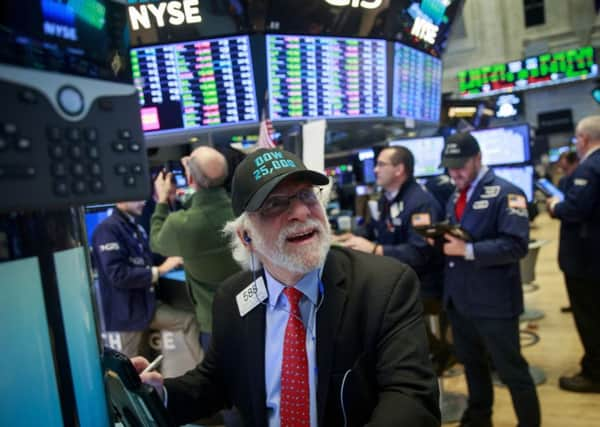Bill Jamieson: Difference between global glee and local gloom is not clear cut


If it looks as if the economic grass is greener on the other side, it’s probably because, well… it is. Local is by no means always global. Economic and financial milestones have been falling worldwide. The world economy is on a roll, enjoying synchronised growth beyond what anyone expected. Growth forecasts are being nudged up and inflation is modest by recent standards.
All this is in the face of widely expected central bank withdrawal of emergency support and tightening this year, and warnings that buoyant stock markets may now be due a correction after the upsurge of recent months.
Advertisement
Hide AdAdvertisement
Hide AdLast week the US Dow Jones Index hit record highs and is now standing 27 per cent up on its 12-month low, buoyant by the prospect of the Trump administration cutting tax. Even more ebullient has been the mood in Tokyo, where the Nikkei 225 Index is up 29 per cent on its 2017 nadir.
Set against those, the performance of the FTSE 100 Index – also hitting new highs last week – looks almost pedestrian, with a gain of “only” 8.7 per cent on its 2017 low.
Asian economies are in buoyant mood. And in the US, despite White House mayhem and turmoil, all major macroeconomic indicators – growth, unemployment, and inflation – suggest 2017 was the American economy’s best year in a decade – and with every sign that expansion will continue this year.
The International Monetary Fund has recently forecast global growth of just under 4 per cent in 2018. Is this not good for us, surely? Is there not a widespread belief that a global rising tide lifts all the boats, so why not ours?
It is certainly true that growth not only raises incomes, but also makes vexing problems such as bad bank loans and budget deficits more manageable. But the problems here are deep-rooted and highlighted daily: continuing uncertainty over the UK’s trade prospects as the Brexit negotiations grind on; continuing falls in real after-inflation household incomes; continuing constraints from a persistent high level of government debt and debt interest; continuing low economic growth with little sign of significant improvement on the horizon; and deepening problems with the UK’s social welfare and health services as the population ages.
In Scotland, business spirits are at a notably low ebb. The latest report from the Federation of Small Businesses out last week finds that business confidence in Scotland has dropped amid what it describes as “bruising” trading conditions. Indeed, confidence rates in Scotland trail those across the UK by 19 points.
Its survey of FSB members finds that the confidence index fell to minus 21.4 points in the final three months of last year, down from minus 15.3 in the previous quarter and is the second lowest level in five years. The business lobby is now calling on the Scottish government to prioritise closing this “persistent confidence gap”.
The FSB’s Scottish policy convener, Andy Willox, says: “Last year’s bruising trading conditions are most likely to blame, compounded with concerns regarding Brexit and worries about local economies.
Advertisement
Hide AdAdvertisement
Hide Ad“These figures show a long-term optimism gap between a typical firm in Scotland and their counterparts elsewhere in the UK. If Scotland is to confound predictions of sluggish economic growth for the foreseeable future, then closing this gap should be a top priority.”
Clearly the Scottish budget does not appear to have lifted morale. And the backcloth is not encouraging. In annual terms, Scottish GDP growth is falling behind UK levels, with Q2 year-on-year growth at 0.5 per cent compared to 1.5 per cent for the UK.
The FSB fears that this persistent confidence gap between UK and Scottish small businesses suggests that the disparity in economic performance will continue.
Here is an example of how “local” factors can cloud the brighter global picture. And it is rare that we see all the world’s major economies growing simultaneously. Apparent “synchronicity” is more often the result of chance rather than co-ordinated central bank design.
To that caveat I would add that the global outlook may not be quite as sanguine as buoyant stock markets might suggest, nor are local circumstances as bleak. The EY Item Club reports a much-needed pick-up in UK productivity in the third quarter as output per hour rose 0.9 per cent quarter-on-quarter – the best performance since the second quarter of 2011. This suggests that some of the first half 2017 weakness in productivity may have been cyclical. Meanwhile, the indications are that productivity likely saw further improvement in the fourth quarter.
And the December purchasing managers’ survey indicated that the UK services sector saw modestly improved activity across the month. The services PMI rose to 54.2 last month after falling back to 53.8 in November from a six-month high of 55.6 in October. The fourth-quarter average of 54.5 emerges above the average for the July – September period of 53.5. December’s modestly improved services survey follows on from a softer but still decent survey for manufacturing and a weaker construction survey.
As for that buoyant global outlook – in such marked contrast to our own – that view has still to price in the likelihood of three interest rate rises by the US Federal Reserve this year, geo-political concerns, particularly in the Middle East, and the vulnerability of global markets to a surprise “event” that could provide the trigger for a significant sell-off.
So the disparity may not prove as wide as it currently appears. In this qualified set of circumstances, the grass elsewhere might look greener for now – until, well, it’s not...